info@gerb.com
Seismic Control of a Steam Turbine Foundation
Elastic support of JPL power plant turbine in Seoni, India.
The site is located near village Barela -Gorakhpur, Tehsil Ghansore of Seoni District. JPL currently has 600 MW thermal capacity fully operational and 660 MW under implementation. The plant is generating power on commercial basis. With a total mass of about 28,750 tons, the turbine house of this power station is approx. 95 m long, 46 m wide and 39-m high.
In 2010, GERB was consulted by the operator of the power plant directly and asked for a vibration control solution. We started supporting the owner as well as the structural designer already at an early project phase. Particular focus was placed on the high earthquake input to be taken into account. Starting with our explanations of similar projects, there were intensive consultations with the project participants about possible optimization of the turbine building. In addition to developing project-specific spring and damper elements, the substructure underneath the elastic support system was discussed in detail.
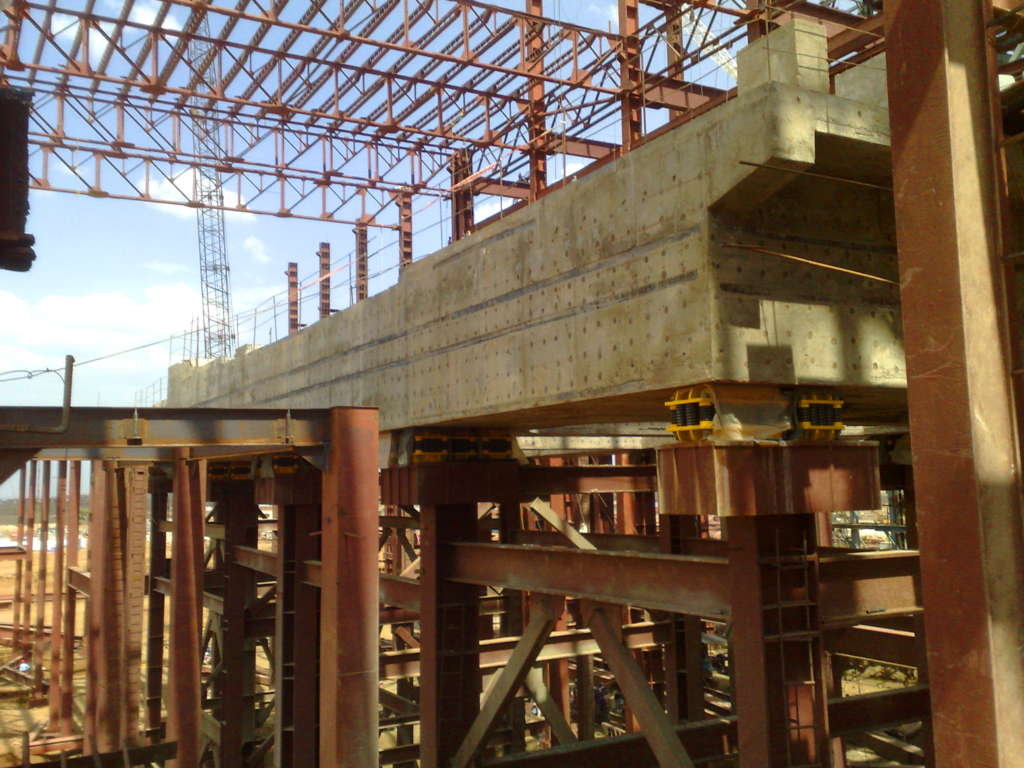
Challenge
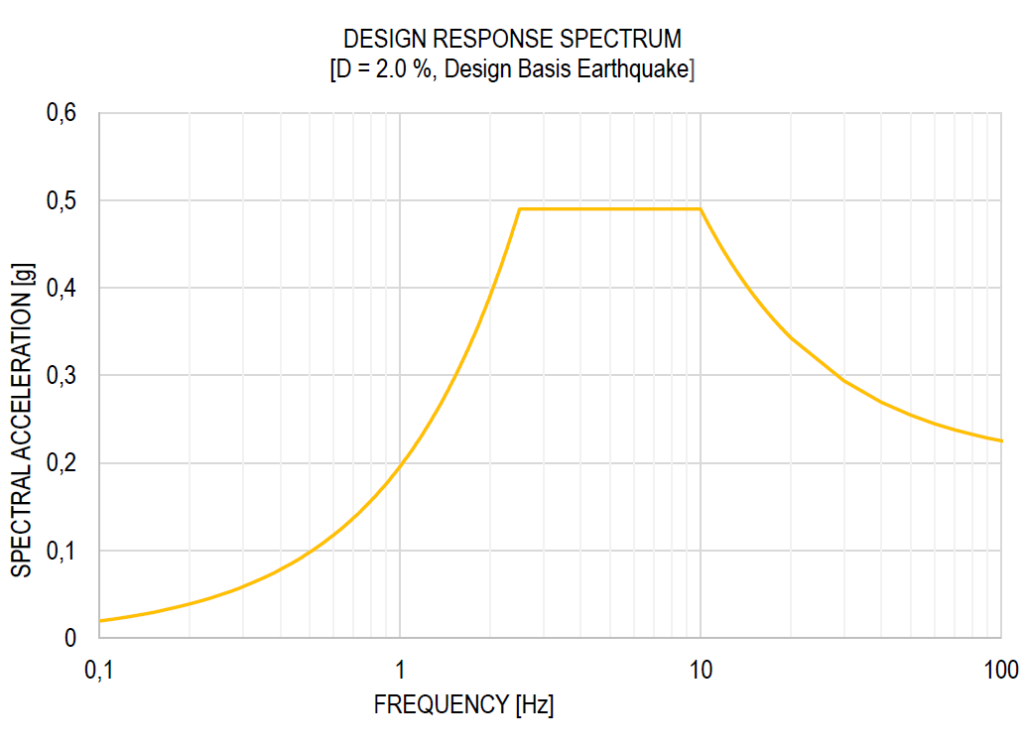
The seismic input required a detailed investigation of the complete
structure. The direct substructure below the vibration isolation
system consisted of reinforced concrete columns, separated from
the adjacent steel structure. The seismic input was defined by
the customer, taking into account site specific investigations. The
input can be described by the design response spectrum (see
figure left).
The seismic design spectrum shows that the frequency range
with the highest acceleration values starts at 2.5 Hz and ends at
10 Hz. The large seismic input required a detailed investigation of
the complete structure. The direct substructure below the vibration
isolation system consisted of reinforced concrete columns,
separated from the adjacent steel structure.
Technical Facts:
Structure: Spring supported turbo-generator foundation
Vibration Source: Earthquake
Support on: 14 Spring-Viscodamper® Combinations and
32 Spring Elements
Weight: ~ 4650 metric tons spring supported
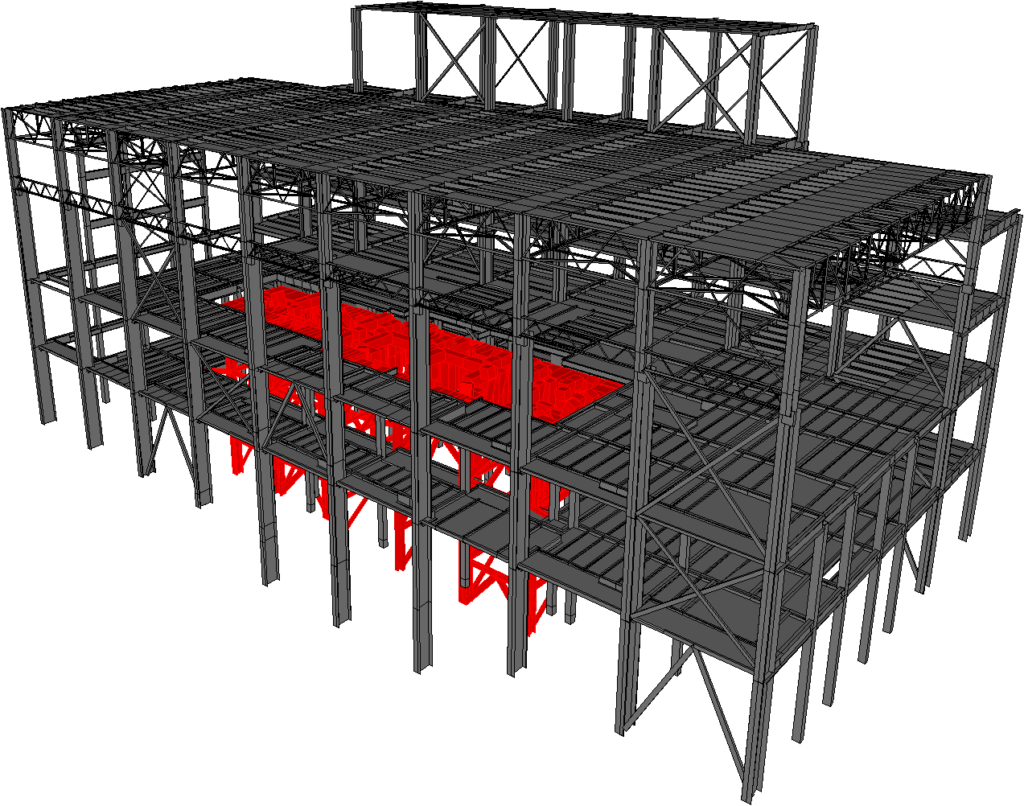
Solution
The process for finding the best suitable solution took place as follows:
- Establishment of a joint project team consisting of GERB India and GERB HQ technical experts, the power plant operator and the structural engineers.
- Visiting Jhabua Power Plant on-site for detailed consultations.
- Developing first ideas and draft of best-practice solution: GERB engineers contributed strongly with a solution-oriented approach, so that the best possible application was developed for this case.
- The developed solution was based on the arrangement of Spring-Viscodamper® combinations and the integration of the substructure into the adjacent steelwork. This adjustment of the overall planning minimised the total construction time.
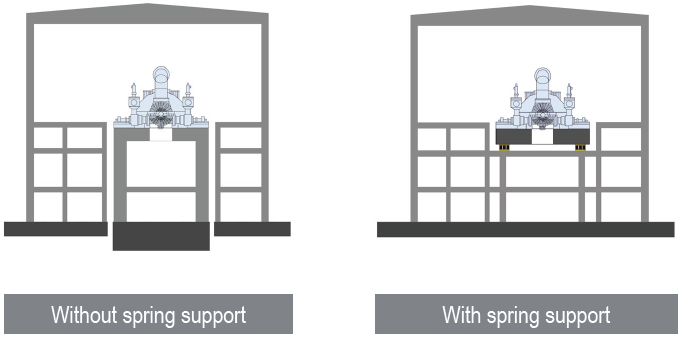
Result
The project was completed in 2012 and major advantages have been
achieved:
- improved behavior of the structure during seismic events.
- easy anchorage of additions (e.g. small pipes / additional braces) to substructure.
- space-savings (Area of substructure)
- time-savings: Due to change of reinforced concrete (below elastic support system) to steel columns it was possible comissioning the plant several months earlier.
Table foundations for turbines have been an almost universal practice in the past. Thick base mats were required as a dynamic “counter mass” to prevent significant settlement, especially in case of poor subsoil conditions. More than 40 years ago, GERB together with the turbine manufacturers has developed the spring support for smaller size turbines. This system was applied for the first time in a nuclear power plant in 1968, to support a 600 MW turbine. Today, GERB spring support is used worldwide for turbines of all capacities up to 1700 MW.
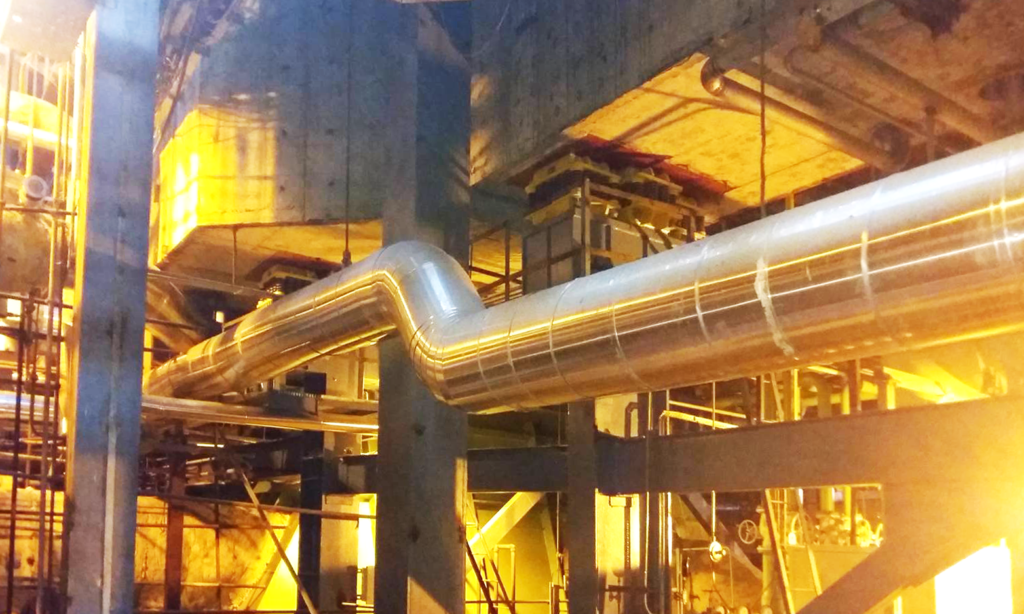
Further Resources
You need further information on this topic?
Please do not hesitate to contact us with your individual question.
One of our project engineers will get back to you shortly.
Seismic Control of a Steam Turbine Foundation
Elastic support of JPL power plant turbine in Seoni, India.

The site is located near village Barela -Gorakhpur, Tehsil Ghansore
of Seoni District. JPL currently has 600MW thermal capacity fully
operational and 660MW under implementation. The plant is generating
power on commercial basis. With a total mass of about 28,750 tons,
the turbine house of this power station is approx. 95 m long, 46 m
wide and 39-m high.
In 2010, GERB was consulted by the operator of the power plant directly and asked for a vibration control solution. We started supporting the owner as well as the structural designer already at an early project phase. Particular focus was placed on the high earthquake input to be taken into account. Starting with our explanations of similar projects, there were intensive consultations with the project participants about possible optimization of the turbine building. In addition to developing project-specific spring and damper elements, the substructure underneath the elastic support system was discussed in detail.
Seismic Control of a Steam Turbine Foundation
Elastic support of JPL power plant turbine in Seoni, India
The site is located near village Barela -Gorakhpur, Tehsil Ghansore of Seoni District. JPL currently has 600MW thermal capacity fully operational and 660MW under implementation. The plant is generating power on commercial basis. With a total mass of about 28,750 tons, the turbine house of this power station is approx. 95 m long, 46 m wide and 39-m high.

In 2010, GERB was consulted by the operator of the power plant directly and asked for a vibration control solution. We started supporting the owner as well as the structural designer already at an early project phase. Particular focus was placed on the high earthquake input to be taken into account. Starting with our explanations of similar projects, there were intensive consultations with the project participants about possible optimization of the turbine building. In addition to developing project-specific spring and damper elements, the substructure underneath the elastic support system was discussed in detail.
Challenge
The seismic input required a detailed investigation of the complete structure. The direct substructure below the vibration isolation system consisted of reinforced concrete columns, separated from the adjacent steel structure. The seismic input was defined by the customer, taking into account site specific investigations. The input can be described by the design response spectrum (see figure).
The seismic design spectrum shows that the frequency range with the highest acceleration values starts at 2.5 Hz and ends at 10 Hz. The large seismic input required a detailed investigation of the complete structure. The direct substructure below the vibration isolation system consisted of reinforced concrete columns, separated from the adjacent steel structure.

Technical Facts:
Structure: Spring supported turbo-generator foundation
Vibration Source: Earthquake
Support on: 14 Spring-Viscodamper® Combinations
and 32 Spring Elements
Weight: ~ 4650 metric tons spring supported
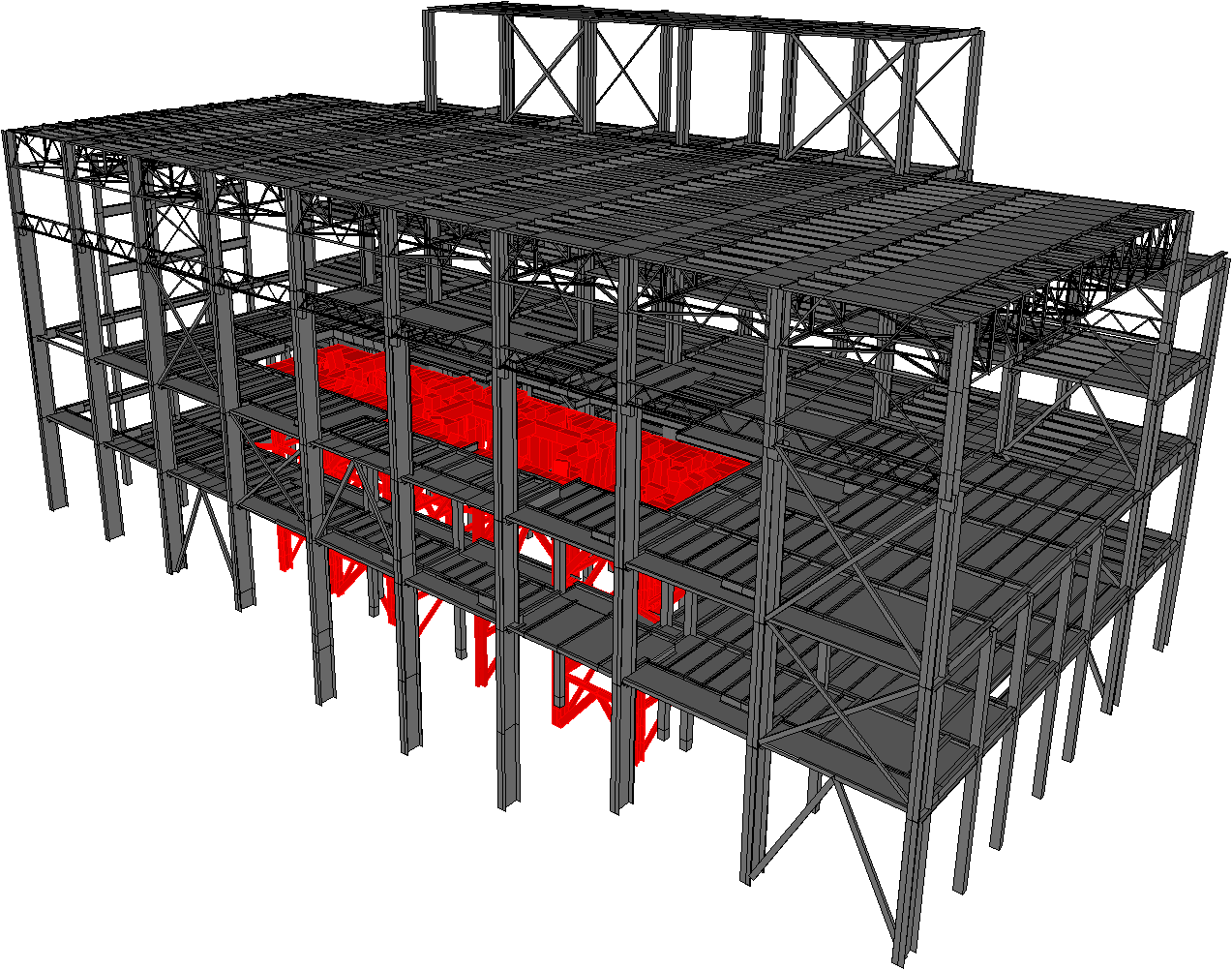
Challenge
The seismic input required a detailed investigation of the complete structure. The direct substructure below the vibration isolation system consisted of reinforced concrete columns, separated from the adjacent steel structure. The seismic input was defined by the customer, taking into account site specific investigations. The input can be described by the design response spectrum (see
figure).

The seismic design spectrum shows that the frequency range with the highest acceleration values starts at 2.5 Hz and ends at 10 Hz. The large seismic input required a detailed investigation of the complete structure. The direct substructure below the vibration isolation system consisted of reinforced concrete columns, separated from the adjacent steel structure.
Technical Facts:
Structure: Spring supported turbo-generator foundation
Vibration Source: Earthquake
Support on: 14 Spring-Viscodamper® Combinations
and 32 Spring Elements
Weight: ~ 4650 metric tons spring supported

Solution
The process for finding the best suitable solution took place as follows:
- Establishment of a joint project team consisting of GERB India and GERB HQ technical experts, the power plant operator and the structural engineers.
- Visiting Jhabua Power Plant on-site for detailed consultations.
- Developing first ideas and draft of best-practice solution: GERB engineers contributed strongly with a solution oriented approach, so that the best possible application was developed for this case.
- The developed solution was based on the arrangement of Spring-Viscodamper® combinations and the integration of the substructure into the adjacent steelwork. This adjustment of the overall planning minimised the total construction time.
- After the solution approach was discussed with all stakeholders, all
quality requirements were fulfilled and the feasibility was verified, it
was jointly decided to implement the GERB application.

The reinforced concrete deck is supported on Spring-Viscodamper® Combinations. The steel substructure below the elastic support system is integrated into the adjacent machine house structure. 3-D Finite element analyses are performed to support the responsible designer and to show the overall efficiency of the optimized support system.
Solution
The process for finding the best suitable solution took place as follows:
- Establishment of a joint project team consisting of GERB India and GERB HQ technical experts, the power plant operator and the structural engineers.
- Visiting Jhabua Power Plant on-site for detailed consultations.
- Developing first ideas and draft of best-practice solution: GERB engineers contributed strongly with a solution-oriented approach, so that the best possible application was developed for this case.
- The developed solution was based on the arrangement of Spring- Viscodamper® combinations and the integration of the substructure into the adjacent steelwork. This adjustment of the overall planning minimised the total construction time.
- After the solution approach was discussed with all stakeholders, all quality requirements were fulfilled and the feasibility was verified, it was jointly decided to implement the GERB application.
The reinforced concrete deck is supported on Spring-Viscodamper® Combinations. The steel substructure below the elastic support system is integrated into the adjacent machine house structure.
3-D Finite element analyses are performed to support the responsible designer and to show the overall efficiency of the optimized support system.

Result
The project was completed in 2012 and major advantages have been achieved:
- improved behavior of the structure during seismic events.
- easy anchorage of additions (e.g. small pipes / additional braces) to substructure.
- space-savings (Area of substructure)
- time-savings: Due to change of reinforced concrete (below elastic support system) to steel columns it was possible comissioning the plant several months earlier.
Table foundations for turbines have been an almost universal practice in the past. Thick base mats were required as a dynamic “counter mass” to prevent significant settlement, especially in case of poor subsoil conditions. More than 40 years ago, GERB together with the turbine manufacturers has developed the spring support for smaller size turbines. This system was applied for the first time in a nuclear power plant in 1968, to support a 600 MW turbine. Today, GERB spring support is used worldwide for turbines of all capacities up to 1700 MW.
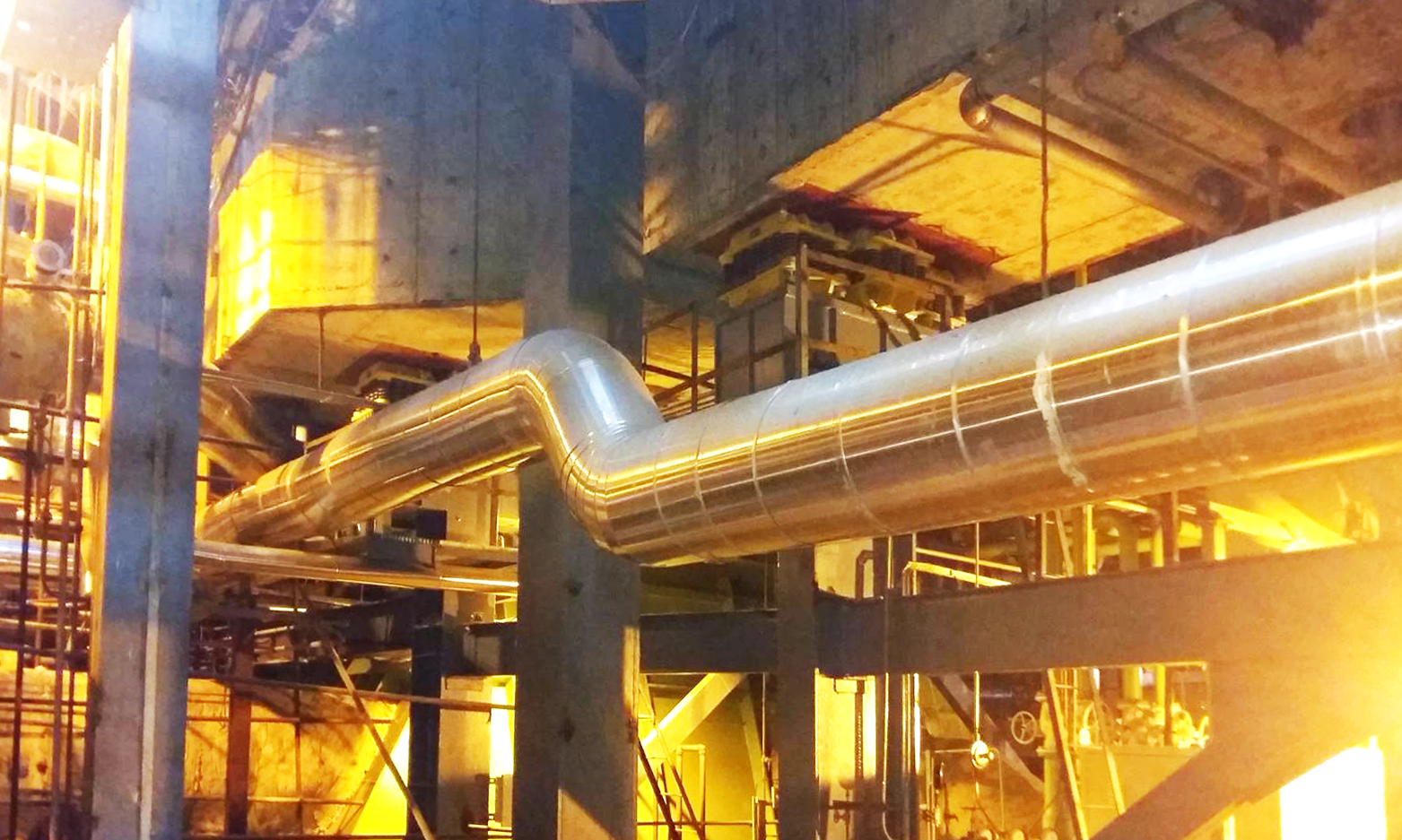
Result
The project was completed in 2012 and major advantages have been
achieved:
- improved behavior of the structure during seismic events.
- easy anchorage of additions (e.g. small pipes / additional braces) to substructure.
- space-savings (Area of substructure)
- time-savings: Due to change of reinforced concrete (below elastic support system) to steel columns it was possible comissioning the plant several months earlier.
Table foundations for turbines have been an almost universal practice
in the past. Thick base mats were required as a dynamic “counter mass” to prevent significant settlement, especially in case of poor subsoil conditions. More than 40 years ago, GERB together with the turbine manufacturers has developed the spring support for smaller size turbines. This system was applied for the first time in a nuclear power plant in 1968, to support a 600 MW turbine. Today, GERB spring support is used worldwide for turbines of all capacities up to 1700 MW.

Share this post
Further Resources
You need further information on this topic?
Please do not hesitate to contact us with your individual question.
One of our project engineers will get back to you shortly.
Further Resources
You need further information on this topic?
Please do not hesitate to contact us with your individual question.
One of our project engineers will get back to you shortly.